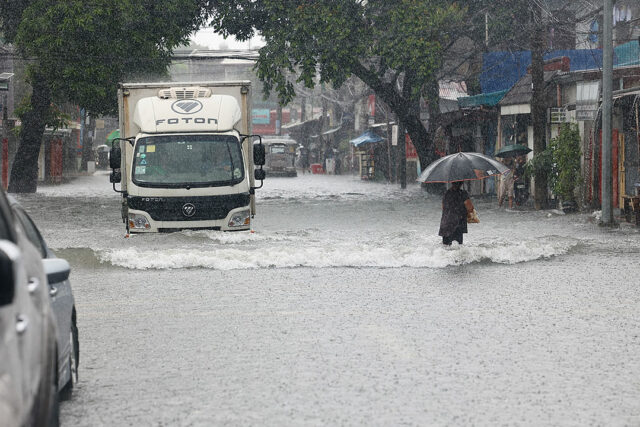It sounds bizarre to talk about the various trappings of Philippine economic growth when many parts of this archipelago are submerged in flood waters during storms.
All that the Government could immediately do was to issue weather advisories that Tropical Storm Kristine, with international name “Trami,” had intensified and that Signal No. 2 was raised in various areas of Bicol and Eastern Visayas. We all needed to prepare for its onslaught. Due to the unexpectedly heavy rainfall, damage to property has been unprecedented. Some local governments have declared a state of calamity which allows them to use their calamity funds for faster relief operations. Such a declaration also triggers a price freeze on essential commodities in the affected areas. Are we doomed to relief and emergency operations?
We can only echo Senator Grace Poe’s disappointment with the so-called underutilization of the flood control budget of the Department of Public Works and Highways (DPWH). In the face of the previous super typhoon Carina, she noted in her resolution last July the downward path of the department’s fund disbursement despite the annual increase in its share of the national budget.
The DPWH budget for this year stands at P822.2 billion, of which over P200 billion or 25% is allotted to flood management. The last five-year average was 20% of its budget was for flood management. Yet, going by what happened in 2023, the department could only disburse 58%, just a bit more than half. Not that there is little to spend. Since Bongbong Marcos became president on July 1, 2022, the Government has spent about half a trillion pesos to address the problem of flooding, especially, of all places, in Metro Manila. But we cannot even perceive the results.
It was a big embarrassment that after the President, during his third State of the Nation Address (SONA) last July, boasted of about 5,000 flood control projects of which about 656 were in Metro Manila, a few days later Carina poured a month’s volume of rain in 24 hours reportedly killing dozens and inundating the metropolis. Those flood control projects proved useless.
For as long as I can remember, even back when I was a grade schooler in the mid-1960s, the Government has been taxing the people P.25 every time they watch movies. If properly disbursed, those accumulated flood taxes could have saved lives and property, and spared Malacañang from this annual massive loss of face.
That is another demonstration of weak governance and weak institutions which are key factors in driving sustainable economic growth and development.
From all indications, the typhoon season also highlights the Philippines’ extreme vulnerability to natural hazards and climate change. The World Bank’s Climate Change Knowledge Portal reported that 60% of the country’s land area and 74% of its population are exposed to various hazards including typhoons, droughts, earthquakes, storm surges, and landslides. We are right on the Pacific “Ring of Fire” and the Pacific typhoon belt. We rank second in the world in annual risk to people from earthquakes and typhoons, experiencing some 270 natural disasters in the last two decades, more than any other country in the world.
Climate change is now exacerbating such vulnerabilities. Changes in weather patterns have resulted in more intense and more frequent disasters in more areas. Five years ago, the International Monetary Fund (IMF) reported that “the time interval between natural disasters has become shorter in the Philippines, implying that the country will typically have less time to recover than in the past.”
To top it all, as early as 2013, the United Nations Development Programme (UNDP) had observed that tropical storms were already hitting areas “that have been historically shielded, while floods and droughts have affected food production.” The vulnerability is intensifying and broadening, climate risks appear to be materializing.
We don’t have to spell it out, but it is obvious that unless we come to grips with this fundamental issue, the country’s macroeconomic gains could be dissipated with one or two major nationwide disasters.
The IMF reported that between 2011 and 2018, 72 storms hit the Philippines, affecting 68 million people with an estimated damage of $15 billion or P825 billion at P55 to a dollar. Based on the country’s development partners led by the World Bank and the United Nations that conducted a comprehensive post-disaster needs assessment, the Philippines’ “average total damage and losses from, and recovery needs to social, productive, and infrastructure sectors after a natural disaster was about 2.7% of GDP”!
The cost of 2013’s Typhoon Yolanda alone was officially estimated at some $13 billion or about 5% of GDP.
All up, natural disasters have sizable adverse impacts on the country’s GDP, current account balance, and fiscal space. Agriculture is the main victim of these natural calamities, compromising food security and pushing food prices up. Since the country’s fiscal space is historically narrow and tax measures cannot be implemented overnight, the Government’s option is to borrow. Hence, risks could be higher for fiscal and debt sustainability.
While the country’s development partners have noted in the past its various initiatives including legislation, climate change expenditure tagging, climate finance, green fund, blue carbon efforts, and climate resilient green growth, the country’s resilience to climate change remains weak. For one, we have yet to see the impact of those half-trillion peso flood control projects.
With substantial budget allocation every year for flood control alone, it’s difficult to reconcile the Philippines topping yet again the list in the World Risk Report for 2024. It was also considered the least resilient country in 2022 and 2023. It scored 58.07 “in the lack of coping capabilities and 56.10 in the lack of adaptive capabilities.” Coping involves various capabilities and actions of the country to fight the negative impact of natural hazards and climate change as well as to minimize the damage after a weather event. Adaptability refers to long-term processes and strategies to anticipate and to counter and mitigate future adverse weather impacts. We scored the lowest on both.
To recall, President Marcos Jr.’s 2024 SONA was spot on when he declared that “The hard lesson of this last year has made it very clear that whatever current data proudly bannering our country as among the best-performing in Asia, means nothing to a Filipino, who is confronted by the price of rice at P45 to P65 per kilo.”
With floods all around us, what is it to us when the IMF, in its October 2024 World Economic Outlook, forecasts the country’s output growth to be one of the fastest in Southeast Asia? Although lower than the official real GDP target of 6-7% this year, the new Fund projection for the Philippines at a lower 5.8% is nonetheless second only to Vietnam’s 6.1%, but ahead of the rest of the ASEAN community. We need to grow more because of the economic scarring during the pandemic and the persistence of poverty and income inequality in the Philippines up to this day.
With floods all around us, some of those growth gains could evaporate in the relief and rehabilitation efforts of both our people and our infrastructure. Even the deep learning deficit among our young children could be set further back because their classrooms are used as evacuation centers during the typhoon season, or during earthquakes and volcanic eruptions.
With floods all around us, talk about the need for economic transformation through technological innovation and digital headways become anachronistic. We don’t talk about AI and machine learning when the needs of our people are reduced to survival, food and water, and a safe place to stay, at least not in the same breath.
Our people’s vulnerability to the harsh reality of life could actually prevent them from achieving higher levels of economic dynamism, that desire and capability to innovate, upgrade productivity, and transform the economy. It’s too hard to expect people who are struggling in the floods, or escaping from volcanic ash, to, as what Nobel Laureate Edmund Phelps wrote in the September issue of the Fund’s Finance and Development, “act on the world.” That spirit of innovation is what inspired the Age of Discovery from the 15th to the 17th century. Or even philosopher Henri Bergson’s spirit that would challenge projects and transform itself in a process of “becoming.”
Something has to be done, and done now, so that these floods would no longer trump those talks about the urgent need to transform the Philippine economy. We owe it to ourselves and to the future.
Diwa C. Guinigundo is the former deputy governor for the Monetary and Economics Sector, the Bangko Sentral ng Pilipinas (BSP). He served the BSP for 41 years. In 2001-2003, he was alternate executive director at the International Monetary Fund in Washington, DC. He is the senior pastor of the Fullness of Christ International Ministries in Mandaluyong.




















